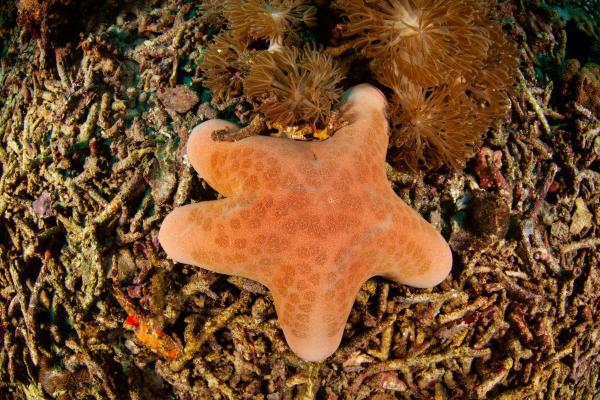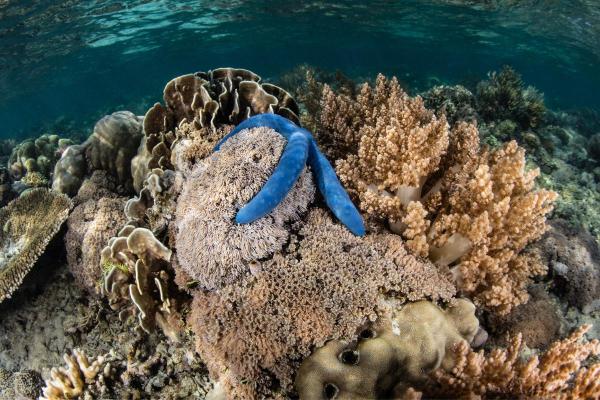Where Do Starfish Live?


Also known as sea stars, starfish are a type of echinoderm that are known for their marine habits. This means that starfish live in the sea. Although we might see a starfish washed up on shore, this does not mean they can live on land. In fact, a sea star will die if out of water for a sufficient amount of time. This is due to desiccation and an inability to respire. They are rather unique animals with a body made of a central disk from which its arms emanate. Moist starfish have five arms, although some species can have many more. They can vary in color, ranging from a reddish orange to purple and many other colors in between. This coloration can be beneficial for surviving in their starfish habitat.
At AnimalWised, we ask where do starfish live? Although we know that starfish live in the sea, the oceans are vast. We want to learn more about the different types of sea star habitat and how they are able to thrive within them.
Where does a starfish live?
Although the celestial body we most associate with starfish are stars, they are also known as asteroids. This is because they belong to the class of echinoderms called Asteroidea. Within this class are almost 2,000 individual species, meaning there is great diversity. Each species may have their own specific habitat in which they live, eat and reproduce.
Starfish live in marine ecosystems, but many people neglect the level of habitat diversity in our world's oceans. Sea stars can live in various depths, whether close to the coast in intertidal zones or high depths of the seabed. In this way, they can live a few thousand meters deep.
Depth is not the only variable in terms of sea star habitat. These types of echinoderms vary their distribution depending on temperatures, being present both in the warm waters of tropical seas and in the icy waters of polar areas.
Let's see below some examples of the distribution of starfish according to species:
- Banded starfish (Luidia alternata): has a wide distribution from the coasts of North Carlina to Argentina. It can be seen in areas of Mississippi, Mexico, the Caribbean and off the Florida coast.
- Seven-armed sea star (Luidia ciliaris): it is common on many coasts of Europe, usually found in tropical and sub-boreal areas. It is seen in the Mediterranean Sea, Atlantic Ocean, British Islands and even in Cape Verde.
- Antarctic sea star (Odontaster validus): it is native to the Antarctic region, common around the continent and on islands in the area.
- Red cushion sea star (Oreaster reticulatus): this starfish habitat ranges from South Carolina to Caribbean waters. It has been introduced in Cape Verde.
- Bat star (Patiria miniata): develops along the coast of the Pacific Ocean from Alaska to Mexico.
- Crown-of-thorns starfish (Acanthaster planci): has a wide distribution in the Indo-Pacific Ocean, with a presence in the Red Sea, East Africa and Japan. Its habitat even extends to Panama and the Gulf of California. It is also common on the Great Barrier Reef in Australia.
- North Pacific starfish (Asterias amurensis): found in lagoons in the North Pacific, close to Japan, Russia, northern China and Korea. However, it is an introduced species in South Australia and Europe. It is so associated with Asia that it is also known as the Japanese common starfish.
- Forbes starfish (Asterias forbesi): its distribution is more restricted than other species, being located on North American coasts from the Gulf of Maine to the Gulf of Mexico.
- Common starfish (Asterias Rubens): the common starfish is distributed in the Atlantic Ocean, but is a boreal type species, meaning it lives in cold climates in close proximity to the Arctic Circle. There is an additional presence in the White Sea and on the coasts of Senegal.
- Starlet cushion star (Asterina gibbosa): it is common in rocky areas of Europe, such as in the southern seas and all around the British Isles.
- Blue star (Linckia laevigata): lives in tropical areas of the Indian and Pacific oceans.
- Northern henricia (Henricia sanguinolenta): also known as the bloody Henry, this species of sea star is found in both the Pacific and North Atlantic. It is also common on the west coast of Scotland.
Now that you have seen where the starfish lives, you can learn more about how it interacts with its habitat in our article on what do starfish eat?

Starfish Habitat
The habitat of sea stars is mainly marine. There are a very few species which can be found in estuarine areas with brackish waters, but it must always be an ecosystem with certain levels of salinity. As we saw previously, they are animals with a very wide global distribution, they are present throughout the world.
The following are the specific types of habitats in which starfish can develop:
- Sandy areas
- Rocky areas
- Frozen seas
- Coral reefs
- Estuarine spaces
- Mangrove areas
- Muddy sediments
- Calcareous seabed
- Seagrass areas
- Rugged coastal areas
- Spaces dominated by algae
- Tropical and subtropical waters
- Oyster, mussel and clam farm areas
If you are learning about where these animals live, you may want to know more in our article asking are starfish vertebrates or invertebrates?
Can starfish live out of water?
Starfish are quite sensitive animals. Depending on the species, they can tolerate certain environmental changes in temperature, salinity, depth, pH, oxygen and light intensity. However, sudden or dramatic changes can be very harmful and certain aspects of their habitats need to be maintained for their survival. For example, some starfish do not tolerate sudden changes or increases in temperature or salinity. They are restricted to waters where these conditions are more or less stable.
One change in habitat that starfish cannot tolerarte is being removed from their aquatic environment. Starfish cannot live outside water for very long because their respiration is from the gas exchange carried out in the aquatic environment. This means they cannot breathe outside of water and will eventually die. Water is also essential for other physiological processes in this animal. You can discover more about this process with our article on how starfish breathe.
Due to the above information, we should never take a starfish out of the water. Many people want to do so to take a photograph or see what they feel like. Although we should generally leave starfish alone, if you do touch one, it should be while they are still submerged in water. Rarely, there are some starfish species which have a mild venom, so these should be avoided altogether. As they are sensitive to various changes, we should leave starfish alone.
If you want to read similar articles to Where Do Starfish Live?, we recommend you visit our Facts about the animal kingdom category.
- Hickman, C, Roberts, L., & Parson A. (2000). Comprehensive principles of zoology. McGraw Hill Inter-American: Spain.
- Mulcrone, R. (2005). Asteroidea. Animal Diversity Web.
https://animaldiversity.org/accounts/Asteroidea/






